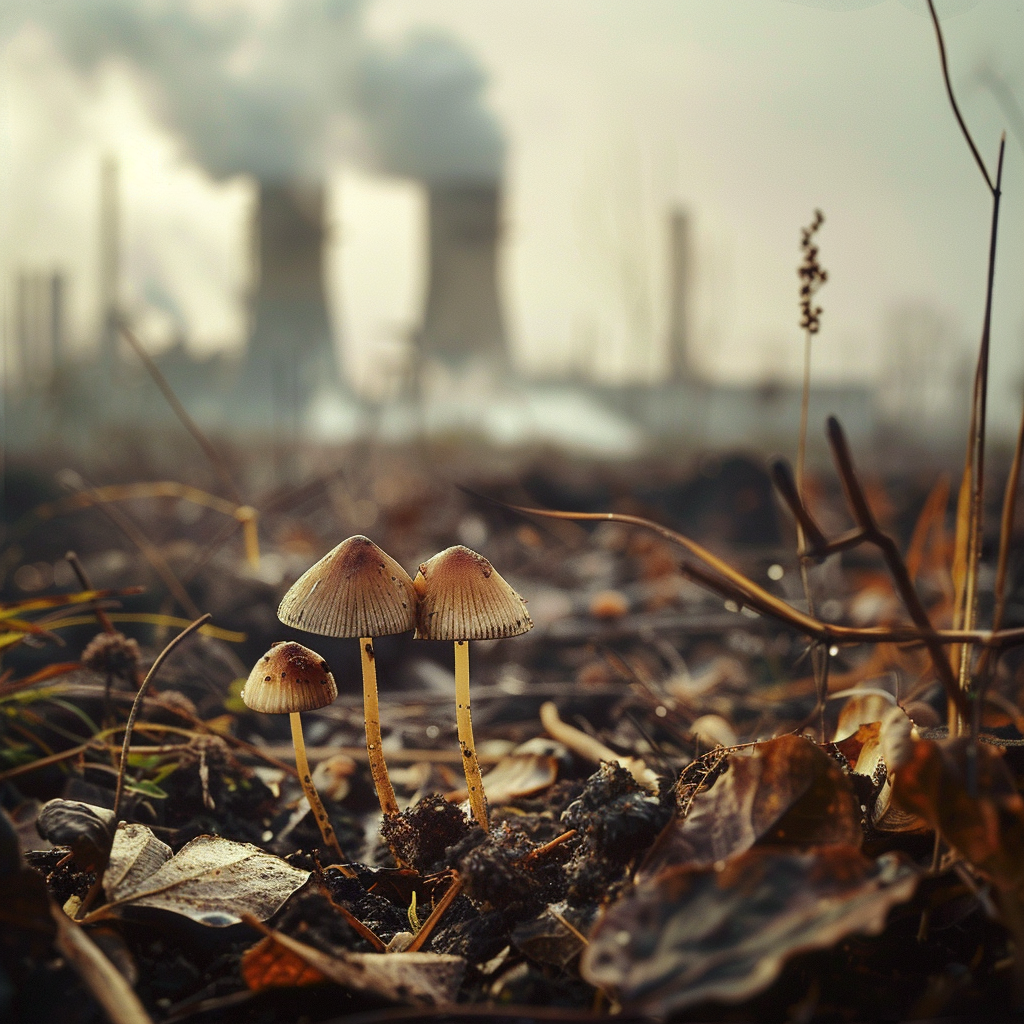
Worried about forever chemicals? Fungi to the rescue!
05/07/24Share
Quick Summary: Teflon was accidentally invented by a DuPont chemist while working on the Manhattan Project to build nuclear weapons during World War II. While extremely useful for that application, the process also created PFAS "forever chemicals" as a byproduct which are now seen as a major environmental and health problem. A new break through shows Mushrooms can break them down.
PFAS, or forever chemicals, were created as a byproduct of Teflon, originally made for the US Government's nuclear weapon program. They have been linked to enormous health issues, and as the name suggests, they never go away. Until now. A fungi, white rot fungus, which sounds really disgusting, can actually break these down. Go fungi! These plucky fungi produce enzymes that can degrade the carbon-fluorine bonds in PFAS, which are known to be extremely strong and resistant to breakdown.
It all began with Teflon, the remarkable polymer known as polytetrafluoroethylene (PTFE), that was an accidental yet pivotal invention during World War II's Manhattan Project to develop nuclear weapons. In 1938, DuPont inadvertently synthesized PTFE while researching materials capable of withstanding the harsh conditions of nuclear reactors and bomb manufacturing processes. Teflon's exceptional heat resistance and anti-corrosive properties made it indispensable for the nuclear program's infrastructure. What could go wrong?
However, the production of Teflon also resulted in the unintentional creation of per- and polyfluoroalkyl substances (PFAS) as by-products. Initially perceived as innocuous, these "forever chemicals" have since emerged as persistent environmental pollutants and potential health hazards due to their longevity and bioaccumulative nature, overshadowing Teflon's original contributions to nuclear technology.
In our modern world, we are surrounded by a vast array of synthetic chemicals and pollutants that can have detrimental effects on our environment and human health. From microplastics to PFAS (per- and polyfluoroalkyl substances), these contaminants have found their way into our water systems, soil, and even our bodies. However, nature may hold the key to mitigating this environmental crisis, and that key comes in the form of fungi – specifically, mushrooms.
What are PFAS and Microplastics?
Before delving into the remarkable abilities of mushrooms, it's essential to understand the contaminants they can help combat.
PFAS, often referred to as "forever chemicals," are a group of synthetic compounds widely used in various products, including non-stick cookware, food packaging, and firefighting foams. These chemicals are incredibly persistent in the environment and can accumulate in the human body over time, posing potential health risks such as birth defects, cancer, thyroid disease, low sperm count, low testosterone, liver damage, and immune system dysfunction.They are bad, really bad and probably already inside you now.
Microplastics, on the other hand, are tiny plastic particles that have infiltrated our oceans, rivers, and even the air we breathe. These minute pieces can originate from the breakdown of larger plastic items or be directly released into the environment through sources like cosmetics and synthetic clothing fibers. Microplastics can be ingested by marine life and potentially enter the human food chain, with unknown long-term consequences.
The Fungal Solution
Enter the unassuming yet remarkable world of fungi. Recent research, including a groundbreaking study from Texas A&M University, has shed light on the potential of certain fungi strains to remove microplastics and break down PFAS from water sources.
In the Texas A&M study, researchers evaluated over 230 different fungal strains and identified three promising candidates: one variety of Aspergillus fungus and two previously undiscovered white rot fungi strains. These fungi demonstrated an impressive ability to capture and concentrate microplastics, forming easy-to-remove pellets.
According to Susie Dai, an associate professor at Texas A&M's Department of Plant Pathology and Microbiology and lead researcher on the study, the Aspergillus strain was able to remove up to 100% of certain microplastics and nanoplastics from water samples. The two white rot fungi strains also exhibited significant "assimilation potential," meaning they could effectively absorb and concentrate these contaminants.
But mushrooms' capabilities don't stop there. Dai and her team have also been exploring the use of fungi to degrade PFAS, those persistent "forever chemicals" that have become a growing environmental and health concern.
Dai's innovative approach involves using plant-derived materials to absorb PFAS, which are then broken down by specialized microbial fungi that literally "eat" these toxic compounds. This groundbreaking technology could potentially be integrated into existing wastewater treatment plants, allowing for the simultaneous removal of microplastics and the degradation of PFAS and other unwanted chemicals.
The Mushroom Advantage
So, what makes mushrooms such effective bio remediators? The answer lies in their unique biology and adaptations.
Fungi are nature's decomposers, playing a crucial role in breaking down organic matter and recycling nutrients in ecosystems. To accomplish this, they produce a wide range of enzymes capable of degrading complex molecules, including those found in synthetic pollutants.
Additionally, many species of fungi have evolved to thrive in harsh environments, making them well-suited for tackling environmental contaminants. Their ability to grow and spread rapidly, combined with their resilience, makes them ideal candidates for large-scale bioremediation efforts.
But perhaps the most remarkable aspect of using mushrooms for bioremediation is their eco-friendly nature. Unlike conventional chemical treatments, which can introduce further harm to the environment, mushroom-based bioremediation relies on natural processes and has minimal negative impacts.
Real-World Applications
While the research on using mushrooms for bioremediation is still in its early stages, the potential applications are vast and exciting.
Imagine wastewater treatment plants equipped with specialized fungal filtration units, capable of capturing microplastics and breaking down PFAS before the treated water is released back into the environment. This could significantly reduce the amount of these contaminants entering our rivers, lakes, and oceans, protecting aquatic life and safeguarding human health.
Furthermore, the ability to recover and potentially recycle the captured microplastics could contribute to a circular economy, transforming what was once a pollutant into a valuable resource.
Beyond wastewater treatment, mushroom-based bioremediation could also be applied to contaminated soil, air, and even industrial waste streams. Researchers are exploring the use of fungal mycelium (the root-like structure of mushrooms) to break down pollutants in soil, while other studies investigate the potential of mushrooms to filter indoor air and remove volatile organic compounds.
The Future of Fungal Bioremediation
While the prospects of using mushrooms for bioremediation are exciting, there are still challenges to overcome. One major hurdle is the diversity of contaminants present in the environment. As Dai points out, the ideal solution would be to find fungi strains capable of capturing microplastics while simultaneously breaking down a wide range of chemical pollutants, including PFAS, pharmaceuticals, pesticides, and cleaning products.
Additionally, scaling up these fungal bioremediation techniques to an industrial level will require significant research and development efforts. Optimizing growth conditions, ensuring consistent performance, and addressing potential safety concerns are just a few of the challenges that must be addressed.
Despite these obstacles, the potential benefits of fungal bioremediation are too significant to ignore. As we grapple with the environmental consequences of our modern lifestyles, harnessing the power of nature's decomposers could be a game-changer in the fight against pollution.
Conclusion: Mushrooms are awesome
Mushrooms to the rescue. In a world increasingly saturated with synthetic pollutants, the humble mushroom may hold the key to a cleaner, healthier future. Through the remarkable abilities of specialized fungi strains, we may be able to remove microplastics from our waterways, break down persistent PFAS chemicals, and remediate a wide range of environmental contaminants.
As research in this field continues to advance, we can look forward to a future where mushrooms play a vital role in restoring the balance of our ecosystems and protecting the planet for generations to come. By embracing the power of nature's decomposers, we can chart a path towards a more sustainable and harmonious coexistence with our environment.
